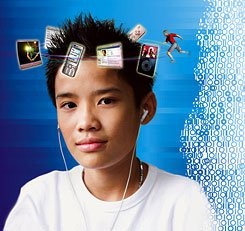Digital learners are students who have grown up immersed in technology, using it seamlessly for learning, communication, and entertainment. But what does it truly mean to be a digital learner in today’s educational landscape? To understand this, we need to go beyond definitions and listen to the voices of students themselves. This article delves into the perspectives of digital learners, exploring their experiences, frustrations, and aspirations for a more engaging and relevant education.
The Digital Divide: Student Perspectives vs. Educational Practices
A striking disconnect exists between how students perceive technology’s role in learning and how educational institutions utilize it. While educators often view technology as a tool to enhance traditional teaching methods, students see it as a fundamental foundation for their learning experiences. This difference in perspective is at the heart of many challenges facing education today.
Students express frustration with passive learning environments where technology is merely a substitute for traditional tools. PowerPoints replacing blackboards, for instance, don’t represent meaningful integration of technology in their eyes. They crave active learning experiences that leverage technology’s potential for collaboration, simulation, and real-world problem-solving.
The Cry for Engagement: Boredom in the Digital Age
A recurring theme in student feedback is the pervasive sense of boredom in classrooms. This isn’t simply a generational complaint; it reflects a fundamental mismatch between teaching methodologies and the learning styles of digital natives.
“School is really, really boring.” (Virginia) – This sentiment, echoed by students across the globe, highlights the urgent need for educational reform.
While some attribute student boredom to continuous partial attention or ADHD, the root cause often lies in pedagogical approaches that fail to engage students meaningfully. Lectures, worksheets, and passive learning activities are simply not effective for digital learners who thrive on interaction, collaboration, and hands-on experiences.
Technology as a Catalyst for Learning: Student Recommendations
Digital learners are not simply demanding more technology; they are advocating for its thoughtful integration into the curriculum. They envision a learning environment where technology empowers them to:
- Explore questions rather than receive answers: They crave inquiry-based learning that fosters critical thinking and problem-solving skills.
- Share opinions and collaborate with peers: Technology facilitates communication and collaboration, enabling students to learn from each other and build collective knowledge.
- Engage with real-world issues and people: Authentic learning experiences that connect classroom knowledge to real-world contexts resonate deeply with digital learners.
- Interact with teachers as equals: They desire a learning environment built on mutual respect and open dialogue, where their voices are heard and valued.
Nearly two-thirds of secondary students desire the use of mobile devices for learning, highlighting the significant gap between student needs and administrative support. This disconnect underscores the importance of involving students in shaping educational policies and practices.
Empowering Student Voices: The Path to Meaningful Educational Reform
The insights of digital learners offer a roadmap for creating a more engaging and relevant education system. By listening to their voices and incorporating their feedback, educators can bridge the digital divide and unlock the full potential of technology for learning. Key takeaways include:
- Embrace bottom-up input: Educational decisions should be informed by student perspectives, ensuring that curriculum and pedagogy align with their learning needs.
- Foster open dialogue: Create opportunities for ongoing conversations between students and educators about teaching and learning practices.
- Empower student agency: Provide students with choices and control over their learning experiences, fostering ownership and motivation.
- Embrace technology as a foundation, not just a tool: Integrate technology in ways that transform learning experiences, not simply replicate traditional methods.
The future of education hinges on our ability to understand and respond to the needs of digital learners. By embracing their perspectives and empowering their voices, we can create learning environments that are not only engaging but also prepare students for success in the 21st century. Ignoring their voices comes at our peril.
